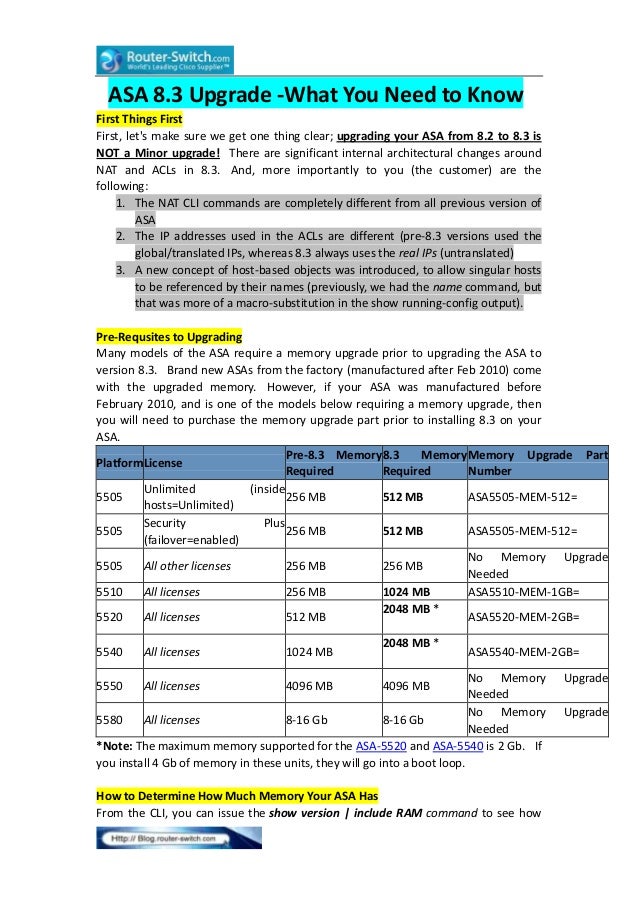Note Even when used on top of an ASA in the same appliance, the FirePOWER NGIDS is never really merged within the ASA but stays a separate module. For instance, the ASA and the FirePOWER each have their own separate CLI shell, each with their own different syntax and logic. In fact FirePOWER is not a Cisco development but has been acquired when Cisco merged with SourceFire, hence the (personal) feeling of an “alien” product plugged into the ASA.
For CCNA Security students, while you must know ASA and be comfortable with its usage, as for now you only need to know what FirePOWER is and why it is used. Cisco ASA can be obtained from various channels: • Cisco ASA entry-level devices target SOHO market and can be bought second-hand for a few dozen of dollars, and brand new for a few hundreds. • Like with the IOS devices, it is possible to extract the required files from an ASA device to use them in a virtualized environment. As far as the CCNA Security curriculum is concerned, even old images are enough for your studies.

Dec 29, 2016 This post will take you through a step-by-step guide to emulate Cisco ASA 8.4.2 on GNS3. In GNS3, QEMU is an emulator which emulates the hardware environment for a Cisco ASA device. Please make sure that your computer has at least 4GB of RAM before you begin.
Being real ASA images, they provide the same functionality and react the same way as real ASA appliances (including vulnerabilities). • For training purposes, Cisco’s network simulator VIRL provides ASAv, an ASA simulator. However, as with any simulator, it may not offer the same features (last time I checked for instance failover was not supported) or react the same way than real gear. The GNS3 simulator doesn’t recommend using ASA images but advise to use ASAv instead. Personally I did not encounter any issue with the ASA images, but that’s most probably because I was satisfied with a old image ( ASA 8.4.2) and basic features.
These a enough for a CCNA Security training. To install ASA you will need the: • ASA itself, depending on the version you chose: • real ASA: you need its Linux kernel ( asa842-vmlinuz for instance) and Initial RAM disk ( asa842-initrd.gz for instance) files. • ASAv emulator: it usually comes as a virtual machine file, such as asav9*.qcow2.
• ASDM: this is ASA GUI, coming as a file such as asdm-7*.bin. Be sure to that the version of ASDM and ASA you are using are compatible.

• A Windows host or virtual machine to administrate the ASA server. • Java must be installed on the Windows host. • A TFTP server for Windows (such as, a portable edition is available which does not require installation on the host). Setting up an ASA server requires three steps: • Booting ASA. 
• Configuring ASA. • Copy ASDM onto the ASA server.
Setting-up ASA in GNS3 is described by Anthony Sequeira in, in particular from the fourth minute onward. While this video relies on a old version of GNS3, the process remains similar: • From GNS3 toolbar, go in Edit > Preferences to open the Preferences window. • In the QEMU > Qemu VMs section, click the New button to create a new virtual machine.
• Be sure to tick the This is a legacy ASA VM checkbox. GNS3 may display a warning recommending to use ASAv instead, but this is fine (see my comment above on this subject).
Note Even when used on top of an ASA in the same appliance, the FirePOWER NGIDS is never really merged within the ASA but stays a separate module. For instance, the ASA and the FirePOWER each have their own separate CLI shell, each with their own different syntax and logic. In fact FirePOWER is not a Cisco development but has been acquired when Cisco merged with SourceFire, hence the (personal) feeling of an “alien” product plugged into the ASA.
For CCNA Security students, while you must know ASA and be comfortable with its usage, as for now you only need to know what FirePOWER is and why it is used. Cisco ASA can be obtained from various channels: • Cisco ASA entry-level devices target SOHO market and can be bought second-hand for a few dozen of dollars, and brand new for a few hundreds. • Like with the IOS devices, it is possible to extract the required files from an ASA device to use them in a virtualized environment. As far as the CCNA Security curriculum is concerned, even old images are enough for your studies.

Dec 29, 2016 This post will take you through a step-by-step guide to emulate Cisco ASA 8.4.2 on GNS3. In GNS3, QEMU is an emulator which emulates the hardware environment for a Cisco ASA device. Please make sure that your computer has at least 4GB of RAM before you begin.
Being real ASA images, they provide the same functionality and react the same way as real ASA appliances (including vulnerabilities). • For training purposes, Cisco’s network simulator VIRL provides ASAv, an ASA simulator. However, as with any simulator, it may not offer the same features (last time I checked for instance failover was not supported) or react the same way than real gear. The GNS3 simulator doesn’t recommend using ASA images but advise to use ASAv instead. Personally I did not encounter any issue with the ASA images, but that’s most probably because I was satisfied with a old image ( ASA 8.4.2) and basic features.
These a enough for a CCNA Security training. To install ASA you will need the: • ASA itself, depending on the version you chose: • real ASA: you need its Linux kernel ( asa842-vmlinuz for instance) and Initial RAM disk ( asa842-initrd.gz for instance) files. • ASAv emulator: it usually comes as a virtual machine file, such as asav9*.qcow2.
• ASDM: this is ASA GUI, coming as a file such as asdm-7*.bin. Be sure to that the version of ASDM and ASA you are using are compatible.

• A Windows host or virtual machine to administrate the ASA server. • Java must be installed on the Windows host. • A TFTP server for Windows (such as, a portable edition is available which does not require installation on the host). Setting up an ASA server requires three steps: • Booting ASA. 
• Configuring ASA. • Copy ASDM onto the ASA server.
Setting-up ASA in GNS3 is described by Anthony Sequeira in, in particular from the fourth minute onward. While this video relies on a old version of GNS3, the process remains similar: • From GNS3 toolbar, go in Edit > Preferences to open the Preferences window. • In the QEMU > Qemu VMs section, click the New button to create a new virtual machine.
• Be sure to tick the This is a legacy ASA VM checkbox. GNS3 may display a warning recommending to use ASAv instead, but this is fine (see my comment above on this subject).
...">Cisco Asa Firewall Ios Image For Gns3 Download(01.03.2019)Note Even when used on top of an ASA in the same appliance, the FirePOWER NGIDS is never really merged within the ASA but stays a separate module. For instance, the ASA and the FirePOWER each have their own separate CLI shell, each with their own different syntax and logic. In fact FirePOWER is not a Cisco development but has been acquired when Cisco merged with SourceFire, hence the (personal) feeling of an “alien” product plugged into the ASA.
For CCNA Security students, while you must know ASA and be comfortable with its usage, as for now you only need to know what FirePOWER is and why it is used. Cisco ASA can be obtained from various channels: • Cisco ASA entry-level devices target SOHO market and can be bought second-hand for a few dozen of dollars, and brand new for a few hundreds. • Like with the IOS devices, it is possible to extract the required files from an ASA device to use them in a virtualized environment. As far as the CCNA Security curriculum is concerned, even old images are enough for your studies.

Dec 29, 2016 This post will take you through a step-by-step guide to emulate Cisco ASA 8.4.2 on GNS3. In GNS3, QEMU is an emulator which emulates the hardware environment for a Cisco ASA device. Please make sure that your computer has at least 4GB of RAM before you begin.
Being real ASA images, they provide the same functionality and react the same way as real ASA appliances (including vulnerabilities). • For training purposes, Cisco’s network simulator VIRL provides ASAv, an ASA simulator. However, as with any simulator, it may not offer the same features (last time I checked for instance failover was not supported) or react the same way than real gear. The GNS3 simulator doesn’t recommend using ASA images but advise to use ASAv instead. Personally I did not encounter any issue with the ASA images, but that’s most probably because I was satisfied with a old image ( ASA 8.4.2) and basic features.
These a enough for a CCNA Security training. To install ASA you will need the: • ASA itself, depending on the version you chose: • real ASA: you need its Linux kernel ( asa842-vmlinuz for instance) and Initial RAM disk ( asa842-initrd.gz for instance) files. • ASAv emulator: it usually comes as a virtual machine file, such as asav9*.qcow2.
• ASDM: this is ASA GUI, coming as a file such as asdm-7*.bin. Be sure to that the version of ASDM and ASA you are using are compatible.

• A Windows host or virtual machine to administrate the ASA server. • Java must be installed on the Windows host. • A TFTP server for Windows (such as, a portable edition is available which does not require installation on the host). Setting up an ASA server requires three steps: • Booting ASA. 
• Configuring ASA. • Copy ASDM onto the ASA server.
Setting-up ASA in GNS3 is described by Anthony Sequeira in, in particular from the fourth minute onward. While this video relies on a old version of GNS3, the process remains similar: • From GNS3 toolbar, go in Edit > Preferences to open the Preferences window. • In the QEMU > Qemu VMs section, click the New button to create a new virtual machine.
• Be sure to tick the This is a legacy ASA VM checkbox. GNS3 may display a warning recommending to use ASAv instead, but this is fine (see my comment above on this subject).
...">Cisco Asa Firewall Ios Image For Gns3 Download(01.03.2019)